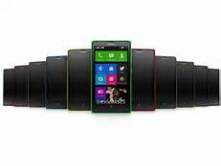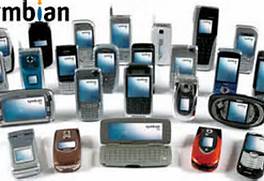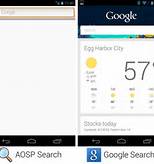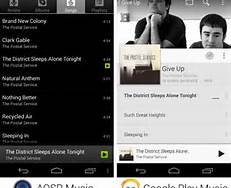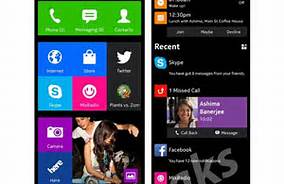Microsoft has a problem. The multibillion dollar software-errrr…devices and services company is the third horse in a frantic race for Mobile dominance. This global competition is led by two steeds who have had a substantial head start, have gained the mindshare of the masses and who have no plans of relinquishing their lead to the Redmond company’s persistent efforts at mobile relevance. Yeah you guessed it, we’re talking about Microsoft’s smartphone OS’s, Windows Phone’s epic David versus Goliath battle against the Android and iOS titans that dominate the mobile Promised Land. Some would say that with Android’s and iOS’s combined market share of about 95% of the global market the battle is over. Microsoft however, like Joshua and Caleb’s positive report after spying the promised land(in contrast to the negative report of the other ten spy’s-tech pundits and reviewers) and seeing the giants, are reporting, “we are well able.” I would encourage the nay-sayers to think again. Microsoft is deadly serious about its mobile endeavors and has gone from 0% market share of its fledgling OS, Windows Phone in October 2010, to a growing 4% today solidly replacing Blackberry as the third player in the mobile space. This is no small feat. In several markets Windows Phone surpasses iOS as the most used mobile OS, coming in second to Android. The Softies have drawn a hard line; they have invested billions to ensure success in this space. Microsoft has a solution.
The Buddy System – Enter Nokia
Nokia which was once a world leader in the cell phone market with the now defunct Symbian mobile OS, in order to save itself (and by default Microsoft’s Windows Phone) had for all intents and purposes, put all of it eggs in Microsoft’s tiled basket. Microsoft and Nokia have been bosom buddies pumping out millions of Windows Phones for the past three years. Nokia who is known for great hardware design succeeded in taking Microsoft’s unique OS to the masses. Microsoft’s bold departure from the mundane static grid and icon based, multi page design of the competing OS’s sport a fluid UI employing dynamic Live Tiles that update and flip with incoming and relevant data. These colorful and minimalistic live tiles which populate the Windows Phone home screen are a far cry from the icon based “me-too” approach shared between Android and iOS.
 The Nokia Lumia 1520 employs dynamically updating Live Tiles to bring users information to the surface.
The Nokia Lumia 1520 employs dynamically updating Live Tiles to bring users information to the surface.
Microsoft’s first move in the new mobile landscape was to present a mobile OS and user interface that was different from the rest. Nokia took Microsoft’s software and crafted it into colorful solidly built polycarbonate devices that complemented the software. The industry noticed. The Nokia Lumia 900 was highly acclaimed. Nokia introduced technologies such as wireless charging, super sensitive screens that could be interacted with via gloved hands, and camera technology that turned the heads of everyone in the industry. Though there were many Nokia fans who cried for a Nokia designed Android device sporting the hardware the company invested in its Lumia line of Windows Phones Nokia was fully committed to Microsoft and the Window Phone platform. The only manifestations of Nokia’s dedication to another mobile OS was to its entry level Asha feature phone line. A Nokia branded smartphone, running Android? Yeah, not likely. Additionally, with Microsoft’s $7 billion purchase of Nokia’s devices division which includes both the Lumia and Asha line an Android based Nokia device seemed even more fanciful. Certainly that’s something we could expect when pigs fly. Well look up.
Flying Pigs
There have been many leaks of late of a device dubbed the Nokia Normandy, or more recently the Nokia X. Screen shots of the device by reliable leaker evleaks show a device sporting Nokia’s classic design language. We hear of specs of a 4” WVGA 800×480 display, 512MB of Ram, a modest 4GB memory, and a microSD port. Low end to mid-range specs to be sure. The device sounds pretty close to the entry level Nokia Lumia 520 Windows Phone. But this phone may be running the latest version of Googles mobile OS of choice Android 4.4 – Kit Kat. They did it. Microsoft’s most vital OEM partner and soon to be smartphone manufacturing arm made an Android smartphone. Not the high end device fans have clamored for but a device running a competing OS nonetheless. And it looks like its coming to market. Is Nokia straight crazy? Or are they courageously brilliant?
Let’s take a closer look at the device. The user interface of this clearly Android based device has the tiled based layout of Microsoft’s Windows Phone OS. Additionally both Microsoft’s and Nokia services/apps appear front and center on the device. I don’t think Nokia is crazy, but if they are they are crazy like a fox.
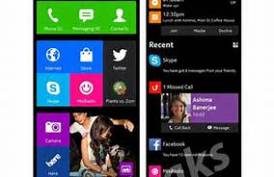
Nokia Android based Normandy is sporting a UI that looks very much like the Windows Phone tiled based Modern UI. Microsoft and Nokia services are likely front and center, with no Google Play apps or services on board. This is likely a forked version of Android(AOSP). Microsoft’s Trojan Phone?
Theory’s, Theory’s, Theory’s
Everything that follows is pure speculation and we won’t know what this all means until time bears the tale. But walk with me. There are, I’m sure a few line’s of thought about Nokia’s move here with the Normandy. So let’s get a couple of things out of the way before we get to the juicy stuff. The less interesting scenario to me is that Nokia is preparing a line of Android devices they can introduce into the market once, with the support of ex-Nokia employees dabbling in other areas of the smartphone arena, Nokia is free to resume smartphone production again in 2016. That’s a plausible theory. Nokia is a loved brand.
Here’s my take. Reminder this is all speculative. Nokia which had become a struggling entity, a mere shadow of its former self, has tied its fate to the success of the Windows Phones OS. They dropped, Symbian which was a dying mobile OS and scrapped Meego (their most recent take on a mobile smartphone OS) in favor of Windows Phone. In the wake of the reinvention and growth of the smartphone market spawned by Apple’s iPhone and iOS and Android led by Samsung, Nokia, a weakening force needed financial backing and a viable mobile OS alternative to compete with the current juggernauts as well as ensure their survival. Microsoft and Windows Phone was the answer.
Nokia utilized their expertise and patented technology that made it a global force to be reckoned with in its hey-day, and Microsoft provided billions of dollars and a partnership to meld the Windows Phone OS onto groundbreaking Nokia hardware. The Lumia line of Windows Phones was born. But it didn’t take the world by storm. Not by a long shot. The competition was deeply entrenched. The climb steep. Apple iphones saturated the upper tier of the smartphone market. Android occupied all tiers but saturated the low end of the market providing an entry into the Android ecosystem. Hmmmmm?
(I wonder?)
Nokia’s own feature phone Asha line, though equipped with access to Nokia’s own branded services was still only a feature phone. Additionally some Android devices are priced at around the same price as Nokia’s higher end non-smarphone devices which have no real app or services ecosystem. Low cost Android devices are becoming a much more tantalizing option to the price conscious cell phone buyers who may have initially considered a feature phone. They are real smartphones, with access to a broad ecosystem and can be bought at around the same price as a higher end feature phone. Well you do the math.
Now Nokia though they are still selling millions of Asha devices, success with feature phones in the low end with comparably priced Android smartphones in the market is just not sustainable. As a matter of fact Asha sales have decreased and it is this Asha line that is Nokia’s bridge to their Lumia line. Their real success would come in the smartphone market. There are billions of consumers whose first or only internet device is a smartphone. The market, particularly in emerging regions is vast. The Lumia 520/521 Windows Phone has been a success in the low end. Windows Phone, which is able to run on low specification hardware, has been a great fit for this low cost device which hit the market at an affordable non-contract price. But Android, particularly with its latest update Kit-Kat, has been modified to run on low specification hardware and has taken aim at emerging markets. What’s a company invested in the Windows Phone OS to do?
Nokia’s Trojan horse
The Normandy/X. Nokia is all in with the Windows Phone platform.
Wait a minute didn’t’ they make an Android phone?
Yep. A low end Android phone that in no way competes with its high end Lumia line of Windows Phones.
This is going to help Windows Phone how?!?
Ok let’s take it slow.
First, the Android code is open source, and though Google owns Android, no one really “owns” Android. Any OEM can take and shape the Android code into whatever they can envision – even a facsimile of the Windows Phone UI.
But wait a minute what about Google?
Ok, here’s the short version. Google bought AOSP (Android Operating System Project) an open source project and has developed it and made it quite successful. But it’s still open source and free for all. At least the AOSP is. What Google has done to try to control something that is free and open is introduce branded services into the mix. Enter Google Play. Google takes services that are part of the free and open AOSP “updates” them with their proprietary API’s and markets them through Google Play. So in a nutshell Google has created two branches of Android – the free and open AOSP version and it’s version that is marketed through Google Play and tied it into its devices and services. You know, apps like Google Calendar, Google Search, Google Play Music, Google Keyboard, Google Camera and Google Hangouts. These and an increasing number of services are tied to many devices consumers purchase.
You see OEM’s – Original Equipment Manufacturers – do have the “ability” to make devices and shape Android as they please. Here’s the problem. If they do this Google won’t let them “Play”. Get it, no access to the very popular Google Play apps that Google has invested in developing and making their own. Now just so that we’re on the same page, there are older AOSP versions of the apps Google has “updated” with it’s API’s, but they aren’t as slick or robust or feature rich as Google’s versions. Take Google Search with Google Now for instance. It’s much more robust than the simple AOSP search app. So if a company decides to make a device with a “forked” version of Android they are blackballed from the Play Store. This pretty much scares many OEM’s into playing by Google’s rules.
Amazon is an example of an exception. They built the Amazon Kindle Fire, and sell content through their own store. This is what other OEM’s who don’t want to play by Google’s terms would have to do. Provide apps and services outside of Google play. Most OEM’s, however, are simply hardware companies with no real software products or services to offer to add value to a non-Google Android device. There are millions of “non-Googled” apps that exist out in the wild, and there are thousands of developers. An OEM would need the resources to build an app store to connect to these apps and developers. An additional challenge that once Google tweaks certain Google based services that some apps tie into, like Google Maps, developers would have to update their apps to keep them working. So the challenge for a developer is keeping the Google Play version of his app current as well as the AOSP version. But it can be done.
Android Open Source Project – Google’s Achilles Heel
Androids market share grew this year. Good news for Google right? Not really. Remember there are two Android camps. Google’s with its Google Play branded apps and services and the free AOSP. The AOSP branch of Android saw greater growth due to the success of OEM’s like Chinas’ Xiaomi. This scares Google; Android growing without it. You see Google has no real physical product that drives its revenue. Its services, distributed through Android devices, (along with ad revenue from Google online) are its bread and butter. An OEM that takes Android and makes it their own, sans Google, is messing with Google’s meal ticket.
Nokia’s Normandy/X project may just take some of Google’s lunch money.
Nokia’s investment in the growing low end market of Android devices via, the Normandy/X has several strategic advantages.
We must first point out that though Nokia is being purchased by Microsoft, they have to conduct business as separate companies and as if no deal is in the works until the deal is sealed. Otherwise there would be anti competition issues. That’s illegal.
So point numero uno: Nokias has invested its smartphone success on its Lumia line of phones. As mentioned above they have achieved a measure of success via the low end Lumia 520/521. Part of Nokia’s over all strategy is to equip their Asha line of feature phones with functionality and services that will entice users to transition to their more competitive line of Lumia smartphones. Now as mentioned above competing Android devices are priced similar to the higher end Nokia Asha devices and they have access to a breadth of android apps. This is a clear advantage these low cost comparably priced Android smartphones have over the limited breadth of functionality of Nokia’s Asha feature phones. Yet in many markets Nokia is still a very popular and loved brand. An affordable Nokia Android device is something many in various markets would quite honestly jump on. Nokia’s strategy with Windows Phone, though yielding positive growth, and introducing groundbreaking devices to market has not yet catapulted the company into a highly competitive position against Apple and Samsung/Android. Huge sums of money, marketing campaigns and incredible hardware have not proven sufficient to substantially breach the walls of Android’s/iOS’ market dominance, mindshare, and mass market appeal. Nokia needed a new tactic. They needed something quieter. More thought out. Strategic. Subversive. How could Nokia continue to support it’s strategy to become a powerful player with Windows Phone based Lumia devices, stem the tide of Samsung’s and others on the low end with their Android devices and create a more viable bridge than it’s suffering Asha line to the Lumia smartphone line?
The Nokia Normandy, the Trojan Phone
Nokia could leverage its good will in the market, its powerful brand to create a device that many would certainly buy. Windows Phone though popular in some markets and growing in popularity in others is still less preferred than Android. Hmmmmm. Nokia could create an Android phone. That would address two issues. One, it could be used to replace the upper tier Asha line that is priced comparably to but is less competitive to other OEM’s Android devices, thus stemming the tide of other Android based OEMs on Nokia turf. This move could even actually grow Nokia’s share of the market. Two, Android is a far more robust OS than that found on an Asha feature phone. It’s an actual smartphone OS. It has access to millions of apps and has functionality that the Asha feature phones simply lack.
Ahhh. But what about Windows Phone? Won’t this undermine Nokia’s efforts to build the Windows Phone ecosystem?
Glad you asked. Like Google, Microsoft provides a breadth of services and software products, such as Skydrive(OneDrive), Office, Skype, Bing, Xbox Music, etc. Nokia has its own range of services as well, Nokia MixRadio, Here Maps, Here Drive and more. Nokia and Microsoft are buddies. Now remember how we said even though Google owns Android, no one really “owns” Android, and an OEM can make it whatever they want- even a facsimile of a Windows Phone UI.
Well check out the display of the Nokia Normandy/X. Looks a lot like the Windows Phone’s tile based user interface doesn’t it? Notice the services that take center stage on the device. Looks like Microsoft and Nokia services to me. Yep, Nokia built a low cost device, running on the forked (AOSP) version of Android focusing on the combined suite of Microsoft and Nokia services, and Google’s nowhere in the picture. Virtually every service Google would provide on an Android device Microsoft and Nokia have comparable or superior alternatives.
Ok so how does this help Nokia and Windows Phone? With this device Nokia offers a device that has a more popular OS than Windows Phone (to those who want Android) but the device is apparently seductively laced with Nokia and Microsoft services as defaults and it’s UI is a facsimile of the Windows Phone Metro UI. Now most people are beginning to realize that when you purchase a smartphone, you are also buying into the services offered by the ecosystem you’re buying into. One of the first things a smartphone user does is log into the device via a user id associated with that particular ecosystem. Once part of the ecosystem, which has services and products that are interconnected,(services such as email, music, gaming, cloud, etc) a user becomes invested and when they go to purchase or upgrade to a new device, they want a device that will keep them in that ecosystem. The Normandy/X is Nokia’s Android based, Microsoft/Nokia laced Trojan Horse.
I believe Nokia is betting on selling the low cost Android based Normandy/X to a Nokia hungry populace eager for a android based Nokia built smartphone. Nokia will give it to them. To the flavor of Microsoft’s mobile UI and the Softies and Nokia’s services and products, sans Google, that is. So hundreds, thousands, ideally millions of Normandy/X (if successful Normandy/X like) phones will be bought but users will also be buying into Microsoft’s ecosystem. They would also be interacting with a device with a UI that looks very much like Windows Phone. So when these same users go to upgrade their devices Nokia will have a line of tried and true, well developed Lumia Windows Phone devices waiting for them. So Nokia via this strategy could hit the low end with two OS’s, tied into Microsoft’s and Nokia’s services and products, Windows Phone via devices like the 525 and an Android phone via the Normandy/X.
Now remember this plan is one that I believe Nokia may have forged acting as if the Nokia/Microsoft buy was not going to occur. Remember anti-competition rules. This slick plan would help dig into Google’s revenue. Google of course fears the untethered use of AOSP; and with good reason. Xiaomi in China builds Android devices which uses none of Google’s services. Xiaomi is growing very swiftly and is quite the powerhouse in China one of the world’s most important markets. This is, I believe one of the reasons for Google’s closer relationship with Android behemoth Samsung. AOSP non-Google Android is growing, while Googles Android is slowing. Now if Samsung goes Tizen that would put Google in a Tizzy.
Now some would say that Microsoft will squash the Normandy/X once the sale goes through. I say, “Maybe not”. We know that Microsoft has shown interest in HTC possibly putting Windows Phone on Android devices. So though this doesn’t reek of Microsoft out right using Android, they have, it seems, considered using the popularity of Android to propel their own platform. Now suppose Microsoft likes Nokia’s subversive idea and they keep the Normandy around. But then wouldn’t they have to manage multiple mobile OS’s? In purchasing the devices line from Nokia they get the Lumia line running Windows Phone and the Asha line running its mobile OS. They have to manage multiple OS’s now. Let’s say they give this Normandy idea a go and it works. They then replace the upper tier Asha line with a forked version of Android devices that looks like Windows phone and ties users into Microsoft services. Now I am aware that Microsoft offers its services on competing devices already but they are not the default. On both Android and iOS devices Goolge and Apple products, respectively take precedence. Not so on the Normandy/X. Microsoft and Nokia will likely be featured front and center.
Now Microsoft, a multi-billion dollar devices and services company can usurp AOSP, create a forked version of Android laced with Microsoft proprietary products and services, (hmmmm sound familiar?), looks like Windows Phone, is dedicated to the low end, to provide a line of devices that act as a bridge to Windows Phone.

Microsoft Office – The worlds most popular Productivity suite comes preinstalled on all Windows Phones.
Developers, Developers, Developers(Finally?)
Microsoft’s foray into AOSP will help them forge better relationships with developers, some of whom will see the potential of the user base that will transition to WP and will be persuaded to begin developing for WP almost immediately. Other developers will wait it out and later witness the transition of this, what will likely be a massive, user base to WP and will then begin developing for WP. Either way, its a long play, and immediate and eventual developer growth is almost certain. Via this undercover entry into an arena where developers thrive, Microsoft will have an opportunity to court developers in a market they are already comfortable in. Relationship is key. The platform through which the relationship is formed becomes secondary to the forging of the relationship itself. Apples success in it’s app ecosystem can lend much credit to the Cupertino company forming critical relationships with developers. Microsoft will have, via the Normandy/X, a powerful bridge to form lasting relationships with developers with whom they can share thier vision of the Normandy/X as a transition device to the Windows Phone platform. With Microsoft’s resources, products and services establishing an Android Google -free app store for developers to peddle thier wares to millions of consumers, who will likely transition to the Windows Phone platform this opportunity for programmers to potentially double thier revenue over time via this migrating user base is a tantalizing proposition. Even if the user bases transition to WP takes longer than desired, if this line of Android phones prove popular among the Android community (linked to Microsoft/Nokia services) in the absence of Google’s alternatives on the devices, Microsoft services will be utilized and likely favored and the facsimile of the tile based UI may become preferred to the icon based grid layout of Android and iOS. If Microsoft and Nokia could use AOSP as a bridge to Microsoft’s Windows Phone, yeah that’s crazy, crazy like a fox. It’s crazy brilliant.










